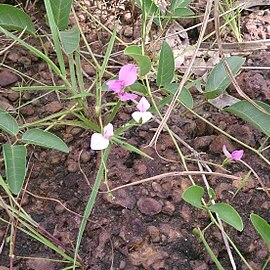Herbs, perennial, climbing. Stems puberulent to densely villous with grayish white or grayish yellow hairs. Petiolules ca. 2 mm; stipels subulate, 1-1.5 mm; leaflets elliptic, oblong, or lanceolate, 2-7 × 1.3-4 cm, papery, sparsely puberulent to densely villous abaxially, sparsely puberulent to subglabrous adaxially, lateral veins 4-8 pairs, slender, slightly raised on both surfaces, veinlets reticulate, conspicuous on both surfaces, base and apex rounded, apex sometimes emarginate, mucronate. Racemes axillary; rachis slender, 2-20 cm. Flowers solitary or often 2-4 clustered at nodes of rachis. Calyx ca. 7 mm, subglabrous to pubescent, tube ca. 3 mm, lobes narrowly lanceolate, apex acuminate. Corolla light blue or pink; standard obovate, ca. 10.5 × 7 mm, base attenuate, with 2 small auricles, apex rounded; wings oblong, ca. 9 × 2 mm, base with a pointed auricle; keel as long as or longer than wings, slightly curved on back, base with a small auricle. Legumes linear-oblong, 2-6.5 × 0.6-0.7 cm, puberulent to villous at first, glabrescent. Seeds brown, reniform, slightly compressed, 2-3.5 × 3-5 mm, smooth. Fl. and fr. Jul-Dec.
Perennial, climbing or trailing herb, 0.6-3.6 m long from a woody rootstock; stems slender, finely pubescent to velvety. Leaves pinnately trifoliolate. Leaflets ± oblong, 20-65 mm long, rounded or emarginate or mucronulate at apex, glabrescent; lower surface pale, sometimes densely appressed-pubescent, hairs grey or rusty. Stipules small, deciduous. Inflorescences lax, 1-10-flowered racemes; flowers in groups of 1-3. Flowers glabrous. Calyx: tube pubescent, campanulate, 2.5-3.0 mm long; lobes ± elliptic, lowest the longest. Petals: standard whitish to pinkish or purple. Pod linear-oblong, compressed, (15-)30-60 mm long, finely appressed-pubescent, 7-or 8-seeded. Seeds yellowish brown to dark blackish red, mottled grey.
Voluble, variably pubescent; leaflets from oval to lanceolato-oblong, glabrous and shining above, paler and pubescent beneath; peduncles equalling or exceeding the leaves, 2-4-flowered near the summit; calyx silky (or glabrescent) with linear-falcate segments.
A climbing bean family plant that keeps growing from year to year. It has a thickened root stock. The stems can be 1 m long.
Flowers pink or blue, the standard petal glabrous.
Twining or trailing


